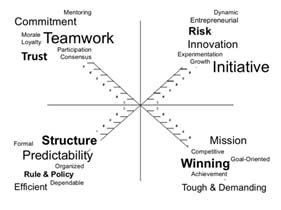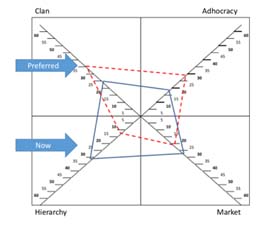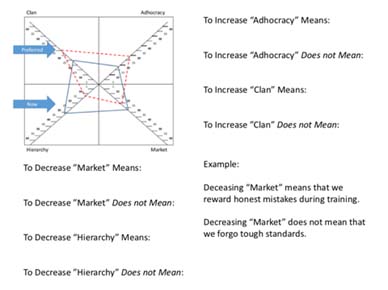Practicing What We Preach: Creating a Culture to Support Mission Command
Thomas M. Williams
Author’s Note. This is a practical guide for unit cultural change - a simple yet powerful tool for command teams to create shared understanding around “what is,” what we would prefer, but most importantly, how to discuss what change means on a day-to-day basis.
When people join an organization, they quickly learn that there is a correct way to perceive, think, feel, and act.[1] In short, they learn the organization’s culture. This culture usually informs how everyone behaves. It permeates areas such as problem solving, decision making, communications, and promotions. It creates insiders and mavericks.
The established insiders of an organization usually like the culture as-is because it led to their success. They do not like change because it puts the mavericks on par, or worse, in charge. Imagine that, they harrumph; we have standards, after all.
We say that we want Soldiers who can practice disciplined initiative, who can change the task to meet the purpose. We profess to want shared understanding and teams built on trust (more than rules). We want them to be risk tolerant.
Yet we do things that scream the opposite. We each have our cases-in-point, but my favorite egregious moment was a Solider booted from Air Assault School because his black socks had thin grey stripes at the toe. He was already through the tests of physical stamina, but the discovery of his packing list violation was too much. He had to go.[2]
Give me a break. Yes, attention to details matters. Yes, there is a balance between free expression and unit cohesion but building a risk-tolerant team does not happen by this sort of narrow conformity. No amount of mission command rhetoric can overcome what this Soldier just learned about Army culture. Follow the rules, or else. It is one example of how our culture typically eats mission command for breakfast.[3]
Cultural change starts with the little things, like how we handle socks. Pointedly if the Soldier brought the finest of non-regulation commercial hiking socks, we should praise the common sense and then teach the Soldier why we expect the uniformity. This kind of change is within our power, and it is what the framework below is designed to elicit. It works for command teams at all levels that want to foster the daily use of mission command yet find themselves in a system that mindlessly adheres to rules and structure.
There are many models to describe and make sense of organizational culture, but the one I favor was developed by Robert Quinn and Kim Cameron in the early 1980s. Called the Competing Values Framework (CVF), it uses an Organizational Culture Assessment Instrument (the OCAI) to survey and depict graphically where your people fit and how they act on differing preferences. [4]
This model is compelling because it is balanced and defies easy prescriptive answers. It is at once friendly to the tenets of mission command yet helps us remain grounded in and responsive to our need to steward a large and complex system. It offers a way for you and your unit to develop simple and concrete action steps toward prudent change without sacrificing what makes the unit work.
Diagnosing the Culture

In Quinn and Cameron’s model there are two intersecting axes on which we find four distinct cultural archetypes. The tip of upper right axis is known as the “Adhocracy” quadrant. The words we can use to describe this quadrant include initiative, innovation, and risk. Opposite them on the competing values axis are the folks who like structure, predictability, and rules. Quinn and Cameron label this quadrant “Hierarchy” and are describing a bureaucracy, but you should not see this word as a pejorative. Without rules adhocracy can devolve into destructive opportunism. On the other hand, without innovation, structure often calcifies. It is a competing values framework because organizations need the best of both values; they pull each other toward the center and toward what Quinn and Cameron call a positive zone.[5]
The other axis (upper left go lower right) juxtaposes a “clan” culture focused on trust, commitment, and teamwork against a high-achieving, mission-focused “market” culture. On this axis the zeal to compete can produce toxic leaders bent on winning at all costs, whereas a team too focused on keeping everyone happy can lose sight of the job that needs to be done. As with the first axis, the opposite value mitigates the negative tendencies of the other.
Organizations can graphically depict how they fall on these axis using a simple survey, the OCAI.[6] The OCAI has only six questions that ask respondents to make clear choices about their beliefs regarding cultural norms. The survey looks at six elements of an organization—its dominant characteristics, its leadership, its management of employees, the “glue” that keeps it together, its strategic emphasis, and lastly, how it defines success.

Respondents take the survey twice, once for what they see as the culture now and once for how they would prefer it to be a few years down the road. There are no right or wrong answers. Many organizations are balanced with “kite” charts that look like squares. Some organizations (like a high-tech firm) skew toward the right and up, as they are entrepreneurial and competitive. A Department of Motor Vehicles might favor structure and team building and skew toward the left and bottom. This makes sense, as you would not want the DMV offering new and creative processes for each visitor. Essentially, the CVF reveals the paradoxical and elastic nature of leading complex organizations in that one must be both mentor and disciplinarian and must enforce rules but encourage and protect mavericks.[7]
As with the accompanying chart, the full story truly begins to take shape when you compare the “now” lines to the “preferred.” Recall that you take the OCAI twice, the second time for what you would prefer to see in your unit. I have used this survey for operational units (when I commanded in a USAR Mission Command Training Brigade) and in academic settings, and I consistently see the same basic results: the now culture they report skews toward the Hierarchy and Market quadrants, and the culture they prefer skews toward the Clan and Adhocracy quadrants.[8]
As I interpret these data and the CVF quadrants, Soldiers—even after disaggregating for rank, unit type, and sex—are saying that they would prefer a Mission Command skew to the current command and control skew.[9] It therefore begs the question: if we all want the same change, what is holding us back?
We could easily blame “the system” (and in many cases we would be right), but that is often a blanket copout. We have plenty of influence with our people in the smallest of every day events. To find out where and how requires that we move past diagnosis and into the next phase, namely discussing what change means and what it does not mean.
With that comes a warning: you your team are probably defining change in unexpectedly different ways. From my experience it is common that a 22-year-old infantry platoon leader and a 44-year-old executive officer will have different understandings of trust, boldness, winning, and what structures are necessary. Not sure? Ask people to define these simple words. It is quite revealing.
Yet both might answer the survey in way that would suggest the same current and preferred culture. It is also possible that identical survey answers are not signs of agreement. Two respondents can have scores and graphs that look the same, but the values underlying their choices are quite different. For example, on one recent survey an operations officer saw a skew toward Hierarchy (on the current culture) as negative whereas her commander saw the exact same skew as positive. In and of itself this might present a problem, but then they saw that their preferred cultures (a skew toward Adhocracy) were about the same. From this we could infer that the operations officer sees a hard road ahead whereas the commander will want only minor adjustments.
With open dialogue you can overlay personality differences, branch, age, and unit type and see similar patterns. What is important to capture from these examples is that “good” is often a matter of perception. The OCAI serves as a visual reference point for exploring these often-unexplored differences or assumed similarities. It provides us with a way to form shared understanding around our boundary systems.
Means/Does Not Mean Conversation
Naturally you do not want a unit culture where Platoon Leaders are free to write their own doctrine or Squad Leaders each developing their own counseling processes. That would fall into Quinn’s negative zone. To create a culture that works on trust, accepts risk, and encourages initiative, you need to clarify meaning and calibrate actions by setting clear left and right limits. You need to define the positive zone. The way to do this is to hold workshops where teams brainstorm exactly what they intend to change.
For each quadrant you are asking two questions. Increasing (or decreasing) this quadrant means X, but it does not mean Y. By offering the former you are charting a clear direction for the team, and through the latter you are setting expectations about maintaining balance. You are also assuaging the worries of those invested in what has proven itself to be acceptable and sustainable. For example, you might say that wanting to be more adaptive means allowing Squad Leaders to devote eight hours each week to working on their own training plans. But you add that it does not mean tossing out the doctrine or standards. Similarly, if you want to reduce bureaucracy, you can hold fewer meetings. This does not alleviate the need to share information. You are simply finding a different way. On the other axis, your team might suggest that fewer formations might communicate greater trust in subordinates. You agree, but your Command Sergeant Major reminds them that this does not mean schedules and accountability go out the window.

As a practical note, you would be well served to use a template for this project. Quinn and Cameron recommend a worksheet for each quadrant, but a “placemat” of similar design works well too.[10] Over the years I have found that this should be a group effort with diverse participants. In other words, team together men and women of different ranks, skills, and personalities. Focus on what you can influence and change; a platoon has no say in the acquisition system so there is little point in saying that change means “less time to upgrade our equipment.”
As the unit’s commander, you should moderate the discussion. As with the above example, you need to play the honest broker, but you should also be prepared to provoke the team. Use the session to ask questions and propose ideas that clarify meaning as well as offer approaches. For instance, if your team is at a loss for ideas and are offering only non-specific platitudes, i.e., “training is NCO business,” then provoke them. Ask, “Does this mean officers should stop attending training meetings?” or better yet, “What if officers did stop going to training meetings?” Lastly, do not allow them to “assume away the problem” by suggesting “it will never happen” or perhaps worse, the unexamined “we already do that!” Your job is to stir the pot enough to generate different points of view or new ideas; ask “what if” or “why not” and see where the conversation goes. Foster shared understanding and ideas will emerge.
Although it is hard not to, refrain from judging ideas too quickly or shutting down the musings of your more creative members. The “means-does not mean” analysis might be a deliberate process, but the sources of innovation are frequently accidental. The beauty of tacit knowledge is that it often becomes explicit when it connects with an unexpected and seemingly random idea. In other words, invest the time so you can tolerate a bit of rambling. Briefing the OCAI and asking people to brainstorm “action steps” is not the same as fostering discussion through questions. A project such as this might take more than one session (in fact there is value in giving your introverts time to process their ideas), but investing the time up front will prevent misunderstanding and resentment later when a unit member thinks he has permission to act in a certain way but discovers he is wrong.
Developing an organizational culture that is at once amenable to the entrepreneurial spirit of mission command but responsive to the needs of the institution and its rules is not easy. Having used the CVF and the OCAI regularly in professional development workshops and teaching, I know them to be powerful tools toward this effort. They make tangible this abstract notion of culture and allow us to see beyond commonplace exhortations such as, “be creative, innovative, and adaptive.” Finally, the deliberative work around agreeing to what change means and does not mean as you review the data from your own organization will provide your team with the confidence necessary to “innovate” successfully.
To learn more about the CVF and how to administer the OCAI, see: Cameron, Kim S., and Robert E. Quinn. Diagnosing and Changing Organizational Culture: Based on the Competing Values Framework. San Francisco, CA: Jossey-Bass, 2006.
End Notes
[1] Schein, Edgar. H. 1990. “Organizational culture”. American Psychologist, 45(2), 109-119
[2] A true story.
[3] Borrowing from the quote often attributed to the late Peter Drucker: “culture eats strategy for breakfast.”
[4] Cameron, Kim S., and Robert E. Quinn. Diagnosing and Changing Organizational Culture: Based on the Competing Values Framework. San Francisco, CA: Jossey-Bass, 2006.
[5] Quinn, Robert E., Faerman, Sue R., Thompson, Michael P, McGrath, Michael, R. Becoming a Master Manager: A Competency Framework. New York: Wiley, 1996, 21.
[6] You will find the survey instrument on pages 23–30 and a discussion of its reliability and validity in Appendix B, pages 163–183, both in Cameron, Kim S., and Robert E. Quinn. Diagnosing and Changing Organizational Culture: Based on the Competing Values Framework. San Francisco, CA: Jossey-Bass, 2006.
[7] Lavine, Marc. "Paradoxical Leadership and the Competing Values Framework." The Journal of Applied Behavioral Science, vol. 50, no. 2, 2014., pp. 189–205.doi:10.1177/0021886314522510.
[8] There is some compelling evidence that the overall Army’s culture skews toward rules and structure, where stability trumps imagination and creativity—see Pierce, James G., and Army War College (U.S.). Strategic Studies Institute. Is the Organizational Culture of the U.S. Army Congruent with the Professional Development of its Senior Level Officer Corps?. [no. 41]. Vol. Carlisle, PA: Strategic Studies Institute, U.S. Army War College, 2010.
[10] You will find sample worksheets for conducting this analysis starting on page 87 in Cameron, Kim S., and Robert E. Quinn. Diagnosing and Changing Organizational Culture: Based on the Competing Values Framework. San Francisco, CA: Jossey-Bass, 2006.
